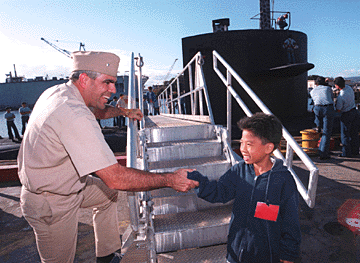



By Burl Burlingame
Star-Bulletin

So why is it that two dozen kids seem to occupy more space and volume than 140 submariners, when both occupy the same submarine at the same time?
Just one of those mysteries. This question was explored last week when kids from Princess Kaiulani Elementary School in Kalihi-Palama -- across from Tamashiro Market -- were invited along on a training exercise by the crew of the USS Louisville.
The 688 Los Angeles-class Louisville, nicknamed "Slugger" when it became the first U.S. submarine since World War II to fire its weapon fo' real -- Tomahawk cruise missiles at Saddam's keister -- a few years ago "adopted" Kaiulani School.
"We've been wanting to do this for two years!" said Commanding Officer Chris Earl cheerfully.
Earl announced that the previous day, 55 of the crew's kids had participated in a similar outing, but, "unlike them, you've got to learn the boat. You'll be trained at each duty station, just like real submariners, and you'll have to get your progress reports filled in."

"She opened the windows and doors to let the smoke out. Well, we can't do that on a submarine. All the air we have, we bring with us. There isn't any more."
This was a sobering thought. The kids had fun trying on the EAB face mask.
The sailors handled any and all questions tossed at them, and were able to answer most of them, except for the first names of the boat's petty officers, which was a genuine puzzler. Submariners are called by the tasks they performed, and the kids were impressed by the sense of teamwork required to drive the 360-foot submarine.
"How do we get electricity under water?" said Chief John Mowka. "We make it! We make everything. We even make air. We bring in seawater, turn it into fresh water, then turn it into mineralized water, then hydrolyze it into oxygen and hydrogen. The hydrogen we vent off into the sea, and we breath the oxygen."

Or a sign that says "NO SPITTING IN THE SCUTTLEBUTT." One of these words is pretty funny to a 10-year-old.
It came time to dive. Christine Chandrabandith, 9, just-drafted helmsperson, seized control of the rudder and fair-water plane controls. She took her under. "It was fun, not scary," Chandrabandith shrugged afterwards. "The Navy would be fun, wouldn't it?"
School Principal Charlotte White took over, and tried to level her out at 150 feet. She managed 149. "You know what you did?" said Petty Officer Hale. "You took a 9,000-ton warship and parked it within a foot of where you wanted it. Pretty good!"
White looked relieved.

In a brief ceremony in the control room, skipper Earl presented newly awarded dolphin insignia to a seaman named Hermes, signifying that he had passed his qualifications. "It just means that he's a SUBMARINER, and that all we need to say in this speech," Earl announced over the intercom, and there was applause through the ship.
"What a difference it's made to have a partnership," said White. "A lot of our kids are from single-parent families, and they don't get out of the neighborhood much. It's a ... challenged ... neighborhood. Things like this give them exposure -- not just to the outside world, but to successful, secure, role-model adults. It's impressive to see such organized teamwork.
"Not just that. Everyone's been really kind to them. These kids need to know that kindness is a human characteristic, too. These positives have been really important.

Mess Steward Carlos Castro identifies with the kids. "I've got the same background," he said. "Just me and my mom and sisters and brothers, growing up in New York. I became a single father, and I swore that I could do better. So I joined the Navy.
"I miss my own kid. It makes me feel good to help these kids -- this is my best day in a while! -- but they also make me realize that I could do even better. So I'm going to study, to try and advance in the Navy."
Caesar Macapagal, 10, had more immediate concerns. "My favorite thing about the trip is the food. Hamburgers and french fries! At school we don't get hamburgers, just sloppy joes, and no lettuce, cheese or tomato."
"What did you learn?" Castro asked Pricilla Tuavale, 10.
"Your submarine is 350 feet long," said Tuavale.
"Whoa!" said Castro.
"That's because I'm smart, yeah?" said Tuavale. "So how come you have so many ladders? Why don't you use escalators?"
"Where do you think you are?" laughed Castro.
Charlene Borce's favorite part of the cruise had nothing to do with the submarine. "They're nice just to pay attention to me," she said.

They loved shooting "water slugs," a jet of super-compressed water in the launch tubes that simulate torpedoes. "Shooting Tube #3!" they'd have to cry. "Stand-by! Three! Two! One! Shoot!" and they'd mash the trigger and the machinery would roar POOOOOM! RRSSSH! SHHUUUAAAH!
"Can I do it again?" asked Gui Xi Xiao, 10.
"Shoot all you want," said Mowka. "We've got all the water in the Pacific Fleet."
Boy, a field trip doesn't get much better than this. The only question is -- who got more out of it, the kids or the sailors?